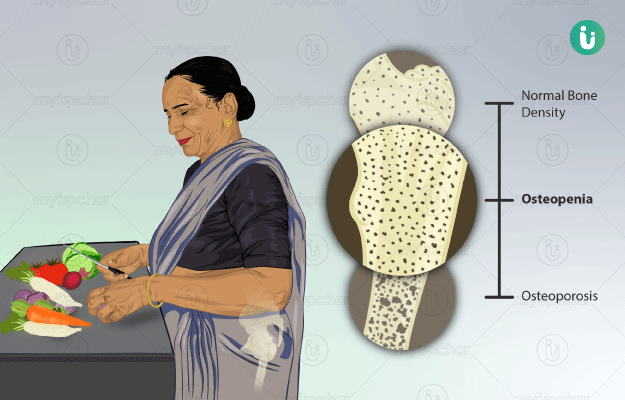What is Osteopenia?
Osteopenia is a condition in which the density of bone is low, leading to weaker bones than normal. Osteopenia is a precursor of developing osteoporosis and increased risk of fractures.
What are its main signs and symptoms?
Generally, osteopenia is symptomless and is noticed only after an individual has a fracture without an obvious cause or a broken bone after a minor fall. This indicates a risk of fracture of other bones too and should be taken as a warning sign of osteoporosis.
What are the main causes?
The cause of this condition is multifactorial and depends on conditions impacting bone strength, which are different for different individuals. The main causes related to this condition include:
- Family history of bad/poor bone health
- Various medical conditions which include a coeliac disease in individuals with allergy to gluten or wheat which also lead to poor calcium and vitamin D absorption from food
- Different medications such as steroids which include glucocorticoid (with long-term use)
- Obesity
- Young female athletes
- Eating disorders.
- Ageing (especially post menopause)
- Deficiency of calcium, and vitamin D due to any reason
- Lack of exercise or inactivity
How is it diagnosed and treated?
The physician will take a complete history of symptoms along with family and medical history followed by an examination of the affected areas. If the doctor is suspicious of you having poor bone health or osteopenia he will further suggest for
- A bone density test and a repeat test will be generally advised two to five years after the first test.
- An X-ray of the affected area in cases of fracture
- Dual-energy X-ray absorptiometry (DEXA or DXA) scan.
Treatment of osteopenia:
- Osteopenia is not as severe as osteoporosis and hence does not require much medication. Treatment of osteopenia targets at protecting the bone and improving its strength.
- Supplementation of the individual diagnosed with osteopenia with calcium and vitamin D is necessary.
- Dietary modification to add foods rich in vitamin D and calcium and includes milk and milk products such as yoghurt, cheese, vegetables such as spinach and broccoli, fish such as salmon, cereals, bread and orange juice.
- Routine exercising and weight management to keep weight in control
- Adopting a bone-friendly lifestyle
- Avoiding smoking and alcohol

 Doctors for Osteopenia
Doctors for Osteopenia  OTC Medicines for Osteopenia
OTC Medicines for Osteopenia



















